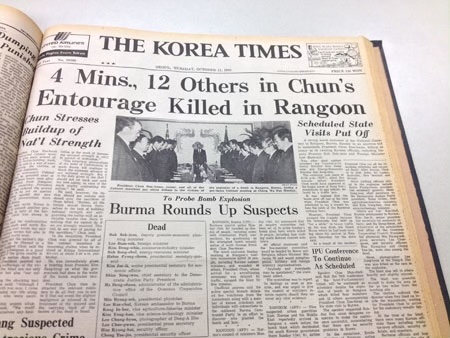
The Rangoon Bombing
How did a secret plan to overthrow a government and incite revolution backfire? This is exactly what happened in 1983 during the Rangoon bombing, when North Korea attempted to assassinate Chun Doo-hwan, the 5th president of South Korea.
In 1983, South Korea was a struggling nation. The country was not only recovering from the heartbreak of a civilian airplane being shot down by communist forces, killing all on the flight, but was also plagued by widespread discontent with the repressive, military-style government employed by Chun Doo-hwan. North Korea saw this chaos and dissatisfaction as their chance to incite revolution and overthrow the government in South Korea.
President Chun Doo-hwan was advised to improve diplomatic relations with other countries by his foreign minister and cabinet, leading him to schedule a six nation tour, stretching over Asia and Oceania. Their first stop was Rangoon, Burma, modern day Yangon, Myanmar. President Chun was set to pay his respects to Aung San, the man considered the father of the nation of Myanmar who was assassinated in 1947, by placing a wreath on his grave in the Martyrs’ Mausoleum in Rangoon. The North Korean government saw Chun’s visit to Myanmar as a place where they could carry out their assassination attempt, hopefully without being accused of the crimes. Three North Korean army officials were assigned to take part in this plan: Kang Min-chuo, Kim Jin-su, and Shin Ki-chul. The army men made their way to Myanmar by ship, which they quietly crept off when it stopped in Rangoon. They then went to a North Korean mission, where they reportedly received three explosive devices, which they hid in the ceiling of the Martyrs’ Mausoleum in preparation for the assassination attempt.
On October 9th, everything was perfectly set in place for the event to go on. Reporters gathered, Chun’s accompanying cabinet members had arrived, and citizens of Myanmar were even assembling to catch a glimpse of the procedure. Then, things began to go wrong. A bugle was supposed to sound signaling President Chun’s arrival, however his car was a few minutes behind schedule due to a traffic jam on his route to the mausoleum. The bugle was accidentally set off a few minutes early, and at its sound, the North Koreans detonated one of the bombs hidden in the ceiling of the mausoleum. The roof ripped open and collapsed, the cabinet members who were assembled in the mausoleum were buried under the roof pilings. Chun was nowhere to be found, as he had still been a few minutes away from the mausoleum when the bugle sounded. The detonation caused mass chaos, and the North Koreans bolted, in an attempt to get away from the attack before being caught. Kang Min Chuo and Kim Jin Su were both chased by the police as they tried to escape. They each attempted to commit suicide by grenade as they were running away, but ended up injuring themselves severely and getting themselves caught. After the bombing, Shin Ki-Chul, the third perpetrator, went missing, but was eventually found as well. He, like the others, tried to resist arrest, but ended up killing himself and three soldiers in this process.
Kang Min-Chul and Kim Jin-Su were both captured and heavily questioned about their involvement in the attack. Kim resisted questioning and continued to deny an involvement in the attack as well as any connection to North Korea, eventually leading to his execution. Kang, however, confessed to his crime and revealed all details of the plan. He was sentenced to life in prison and passed away in 2008 of liver cancer.
Despite the devastating effects of the Rangoon bombing, killing 21 people as well as injuring 46 more, it did not reach North Korea’s true goals. North Korea hoped to incite revolution in the turmoil of an assassination of the South Korean president. Rather than doing this, the event backfired and caused drastic effects for North Korea’s reputation on the world stage. Although they denied involvement in the plan, 69 different countries spoke out and criticized the North, with several other countries deciding to cut diplomatic ties entirely. Myanmar, which had previously been tied to the North, completely cut their relations, and did not reopen them until 2007, more than two decades later. Even China, one of the North’s main allies, refused to speak to the government of North Korea for months following the attack.
In all, the Rangoon bombing of 1983 did cause heartbreak and chaos in South Korea and Myanmar, but most importantly drastically backfired on North Korea and their goals, soiling their image on the world stage and breaking some important ties for the nation.
This was the politics… stay tuned for the dinner!


You May Also Like

Bûche de Noël with a Mexican twist
16 December 2024
On this day – January 2, 1980
2 January 2024